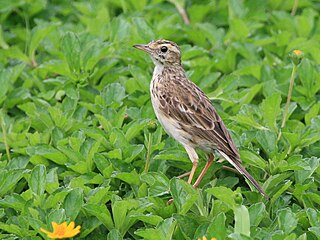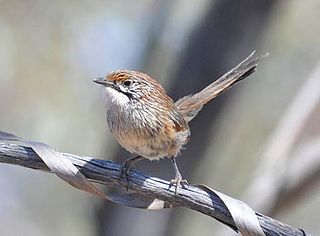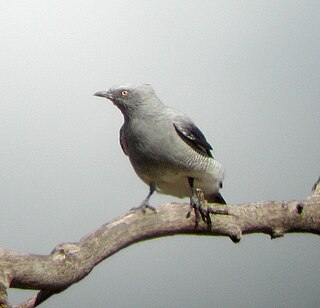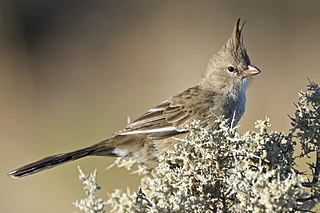
Platysteiridae is a family of small, stout passerine birds of the African tropics. The family contains the wattle-eyes, batises and shrike-flycatchers. They were previously classed as a subfamily of the Old World flycatchers, Muscicapidae. These insect-eating birds are usually found in open forests or bush. They hunt by flycatching, or by taking prey from the ground like a shrike. The nest is a small, neat cup, placed low in a tree or bush.

Psophodidae is a family of passerine birds native to Australia and nearby areas. It has a complicated taxonomic history and different authors vary in which birds they include in the family. In the strictest sense, it includes only the 5 or 6 species of whipbirds and wedgebills, but some authors also includes at the quail-thrushes (Cinclosoma), 8 species of ground-dwelling birds found in Australia and New Guinea, and the jewel-babblers (Ptilorrhoa), 3 or 4 species found in rainforest in New Guinea. Others place them in their own family, the Cinclosomatidae. The Malaysian rail-babbler was formerly sometimes placed in this family, which would then be called Eupetidae.

The ring-necked dove, also known as the Cape turtle dove or half-collared dove, is a widespread and often abundant dove species in East and southern Africa. It is a mostly sedentary bird, found in a variety of open habitats. Within range, its penetrating and rhythmic, three-syllabled crooning is a familiar sound at any time of the year. Its name is derived from the semi-collar of black feathers on the lower nape, a feature shared with a number of Streptopelia species. Like all doves, they depend on surface water. They congregate in large flocks at waterholes in dry regions to drink and bathe.

The eastern whipbird is an insectivorous passerine bird native to the east coast of Australia. Its whip-crack song is a familiar sound in forests of eastern Australia. Two subspecies are recognised. Heard much more often than seen, it is dark olive-green and black in colour with a distinctive white cheek patch and a crest. The male and female are similar in plumage.

The long-tailed silky-flycatcher is a passerine bird which occurs only in the mountains of Costa Rica and western Panama, usually from 1,850 m altitude to the timberline. It is a thrush-sized species weighing about 37 g. The silky-flycatchers are related to waxwings, and like that group have soft silky plumage.

The Australasian pipit is a fairly small passerine bird of open country in Australia, New Zealand and New Guinea. It belongs to the pipit genus Anthus in the family Motacillidae.

Psophodes is a genus of five species of songbirds endemic to Australia, known as whipbirds and wedgebills.

The Madagascar snipe is a small stocky wader. It breeds only in the humid eastern half of Madagascar, from sea-level up to 2,700 m, being more common above 700 m. It is non-migratory.

The wedge-tailed jery is a small bird endemic to the east of Madagascar. The species has been the cause of some taxonomic confusion, it was originally placed with the jeries in the genus Neomixis (Cisticolidae) before being placed in its own monotypic genus Hartertula, but still considered close to Neomixis. Recent research indicates it is part of an endemic Malagasy radiation currently known as the Malagasy warblers.

The Australian crake , also known as Australian spotted crake, or spotted crake is a species of bird in the family Rallidae. It is one of three species of Australian crakes in the genus Porzana, the others being the spotless crake and Baillon’s crake.

The striated grasswren is a small, cryptically coloured ground-dwelling species of wren-like bird in the family Maluridae, endemic to Australia. It occupies a large discontinuous range across arid and semi-arid areas of western, central and southern Australia where it is associated with spinifex (Triodia) grass.

The Senegal batis is a species of small passerine bird in the wattle-eyes family, Platysteiridae. It occurs in western Africa where it is found in dry savanna and subtropical or tropical dry shrubland. It was originally given the binomial name Muscicapa senegalensis by Carl Linnaeus in 1766.

The chestnut quail-thrush is a native Australian bird of the family Cinclosomatidae. These scrub birds are endemic to Australia and found in all states - barring Tasmania. They are relatively uncommon and are isolated to the semi-arid and arid fringes of the Australian interior.

The ground cuckoo-shrike is an uncommon bird species endemic to Australia, occurring mainly in open woodland and arid grasslands throughout inland Australia, but also occasionally in areas on the east coast.

The orange chat is a species of bird in the family Meliphagidae. It is endemic to Australia.

The rockwarbler, is a bird in the family Acanthizidae. It is the only bird species endemic to the state of New South Wales in Australia.

The chiming wedgebill, sometimes referred to as chiming whipbird is a species of bird in the family Psophodidae. It is endemic to Australia. The chiming wedgebill and chirruping wedgebill were considered a single species until as late as 1973, when they were separated due to marked differences in their calls.

Wedgebill or wedge-bill is a common name for several birds and may refer to


















